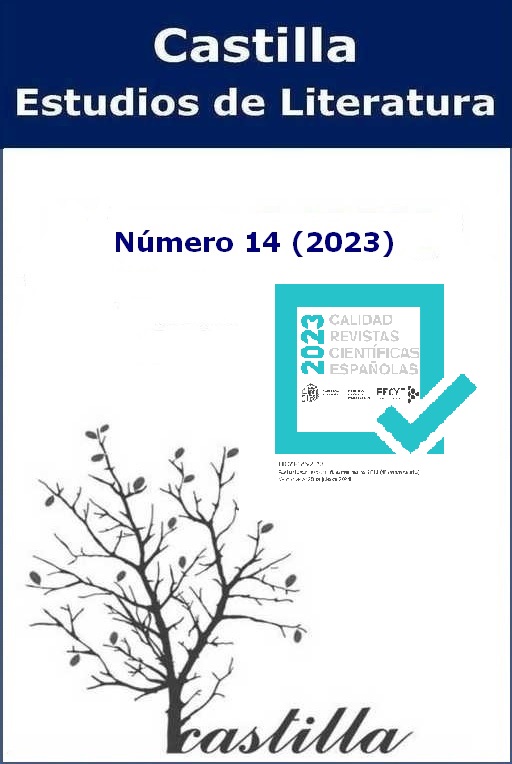The Interactive Poetry of José Aburto: Logophagic and Logoemetic Approaches
DOI:
https://doi.org/10.24197/cel.14.2023.92-108Keywords:
José Aburto, text-visual poetry, logoemesis, electronic literature, interactive artsAbstract
This article approaches the poetic work of the Peruvian author José Aburto (1977) from the notion of logoemetics as a form of conceptual access to the interactive mechanisms of the digital textuality and its mediation on the screens. To do so, I outline an approximation to the notions of both logophagy and logoemesis as frameworks to approach the text-visuality and its invisibility and visibility. Thus, through a representative sample of an interactive poems’ corpus, I establish the significant relevance that interfaces and interaction suppose for the reception process of these works in their creative space in an inherent manner.
Downloads
References
Aburto, José (1999), “Jose”, http://joseaz.pe/ [12/01/23].
Aburto, José (2000), “Paranoico arcoíris”, http://joseaz.pe/entalpia/_dig/arcoiris/ [fecha de consulta: 12/01/23].
Aburto, José (2002), “Aplicación de la fuerza de gravedad a los cuerpos inmóviles”, http://joseaz.pe/entalpia/_dig/gravedad/ [fecha de consulta: 12/01/23].
Aburto, José (2003a), “Concepción del dragón”, en inesperada. http://joseaz.pe/entalpia/_dig/dragon/ [fecha de consulta: 12/01/23].
Aburto, José (2003b), “Conversación”, en http://joseaz.pe/entalpia/_dig/conversacion/ [fecha de consulta: 12/01/23].
Aburto, José (2003c), “Grita”, en https://www.joseaz.pe/_dig/grita/index.html [fecha de consulta: 12/01/23).
Aburto, José (2007), “Arte Poética”, en http://joseaz.pe/entalpia/_dig/poemas/poetica.html [fecha de consulta: 12/01/23].
Aburto, José (2008), “En movimiento”, en http://joseaz.pe/entalpia/_dig/enmovimiento/ [fecha de consulta: 12/01/23].
Aburto, José (2017a), “Condensaciones”, en http://joseaz.pe/entalpia/_dig/poemas/condensaciones.htm [fecha de consulta: 12/01/23].
Aburto, José (2017b), “Disolvencias”, en https://www.facebook.com/joseAZpoesia/photos/a.1800129843592142/1817090095229450/?type=3&theater [fecha de consulta: 12/01/23].
Aburto, José (2018), “Somos”, en http://joseaz.pe/entalpia/_dig/poemas/somos.html [fecha de consulta: 12/01/23].
Aburto, José (2020), “Polos iguales”, en http://joseaz.pe/entalpia/_dig/polos/index.html [fecha de consulta: 12/01/23].
Bishop, Judith; Horspool, R. Nigel; Xie, Tao; Tillmann, Nikolai y Halleux, Jonathan de (2015), “Code Hunt: Experience with Coding Contents at Scale”, en Antonia Bertolino (coord.), Proceedings of the 37th International Conference on Software Engineering, Piscataway, Wiley-IEEE Press, pp. 398-407.
Blesa, Túa (1998), Logofagias: Los trazos del silencio, Zaragoza, UNIZAR.
Blesa, Túa (2011), Lecturas de la ilegibilidad en el arte, Salamanca, Delirio.
Brea, José Luis (2007), Cultura_RAM. Mutaciones de la cultura en la era de su distribución electrónica, Barcelona, Gedisa.
Brea, José Luis (2010), Las tres eras de la imagen, Madrid, Akal.
Chaparro Gómez, César (1981), “Acercamiento a la carmina figurata. P. Optaciano porfirio (C. XXVI)”, Anuario de estudios filológicos, 4, pp. 55-69.
Davis, Joe (2010), “Telescopic Text”, http://www.telescopictext.com [fecha de consulta: 12/01/23].
D’Ors, Miguel (1977), El caligrama, de Simmias a Apollinaire. Historia y antología de una tradición clásica, Pamplona, Ediciones Universidad de Navarra.
Escandell Montiel, Daniel (2017), “Logoemesis y cultura textovisual: Figuras de la generación y visibilización del texto en el arte escrito mediado por las pantallas”, Tropelías. Revista de Teoría de la Literatura y Literatura Comparada, 27, pp. 56-66. DOI: https://doi.org/10.26754/ojs_tropelias/tropelias.2017271540.
Escandell Montiel, Daniel (2019), “Emergencia textual: La logoemesis como definidora de la interacción con el texto digital”, Metodologías humanísticas en la era digital, 2, pp. 141-155.
Escandell Montiel, Daniel (2022a), “Fugas y centros de la altermodernidad: ante la perspectiva de lo exocanónico”, en Daniel Escandell (ed.), Escrituras hispánicas desde el exocanon, Madrid-Frankfurt, Iberoamericana-Vervuert, pp. 7-22.
Escandell Montiel, Daniel (2022b), “José Aburto”, https://exocanon.usal.es/dipes/jose-aburto/ [fecha de consulta: 12/01/23].
Gordon, Samuel (1997), “La influencia japonesa y caligramática en las formas poéticas breves latinoamericanas”, América. Cahiers du CRICCAL, 18(2), pp. 319-328.
Halleux, Peli de (2014), Code Hunt, Microsoft.
Jones, Nathan Allen (2022), Glitch Poetics, Londres, Open Humanities Press.
Klei Entertainment (2015), Invisible, Inc. Klei Entertainment.
Muriel Durán, Felipe (2000), La poesía visual en España, Madrid, Ediciones ALMAR.
Pron, Patricio (2014), El libro tachado, Madrid, Taurus.
Przybyszewska, Agnieszka (2019), “José Aburto Zolezzi: El autor en busca de la interfaz literaria ideal”, Zagadnienia Rodzajów Literackich, LXII(4), pp. 119-130. DOI: https://doi.org/10.26485/ZRL/2019/62.4/8.
Rodríguez de la Flor, Fernando (2009), Giro visual. Primacía de la imagen y el declive de la lecto-escritura en la cultura postmoderna, Salamanca, Delirio.
Ullán, José Miguel, (1976), Alarma, Madrid, Trece de nieve.
Downloads
Published
Issue
Section
License
Copyright (c) 2023 Daniel Escandell Montiel

This work is licensed under a Creative Commons Attribution 4.0 International License.
This journal enables free and immediate access to its content to foster global knowledge.

The articles published at Castilla. Estudios de Literatura will have a Creative Commons Attribution 4.0 International License (CC BY 4.0).
The authors continue as owners of their works, and can republish their articles in another medium without having to request authorization, as long as they indicate that the work was originally published in Castilla. Estudios de Literatura.



